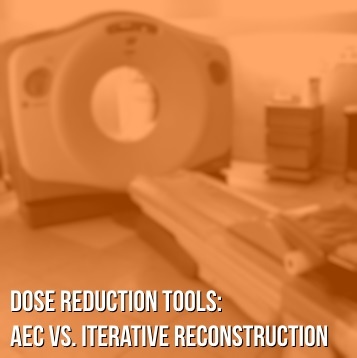
Radiation dose in CT scanning has always been something users have sought to minimize. In recent years, however, the call to develop tools that make dose reduction intrinsic to the way we scan, instead of a guideline that we strive to follow, has become much louder.
CT manufacturers have responded to this call with a variety of features that work in different ways, sometimes together, to reduce overall radiation dose. We're going to look at automatic exposure controls (AEC), using GE's AutoMa and SmartMa as examples, as well as iterative reconstruction (IR) to see how they are different from one another and how they work together to bring the dose down in CT.
Automatic Exposure Controls
AEC works during a CT scan, adjusting the radiation up or down as needed to optimize it for the anatomy being scanned in a given slice. In our GE examples, AutoMa responds to the radiation attenuation of tissues along the Z axis while SmartMa, informed in part by the data gathered by AutoMa, responds to the position of the X-ray source relative to the patient along the X and Y axes.
Iterative Reconstruction
IR begins its work after a slice has been captured, during the process of reconstructing the image data into a fully-rendered picture. As a dose reduction tool, IR gets the job done indirectly- without taking any action that raises or lowers the radiation level a patient is exposed to during a scan.
The original method of CT image reconstruction, filtered back projection (FBP), is subject to a certain amount of image noise which, at higher levels, can limit the diagnostic usefulness of an image. One way to reduce image noise is to increase the radiation dose. While this can be done within approved limits, it's not ideal. Reconstruction methods like IR (known by a number of names, depending on the manufacturer) reduce image noise by starting with FBP data and applying additional algorithms. This allows the CT tech to use a lower radiation dose to begin with and get a less noisey image than reconstructing with FBP alone.
The Takeaway
With AEC optimizing the application of dose during a scan and IR creating clearer images from lower starting dosages, the tools that are now available work at every stage of the imaging process to help reduce radiation exposure. If top-of-the-line dose reduction tools are a priority for you, and there's room in your budget, you'll want a CT scanner that has both of these. If NEMA XR-29 compliance is part of your considerations, be aware that while AEC is a requirement, IR is not. You can learn more about what XR-29 is and what it requires here: NEMA Standard XR-29 for CT- What Does It Mean for You?
On the other hand, with more tools, comes a higher price. IR is newer and tends to be featured on systems that occupy the higher end of the price spectrum. AEC has been around long enough that it is a standard feature on most CT scanners, new or used. If you're operating under tighter budget constraints, a CT with AEC but no IR is still a powerful step toward a more dose-efficient future for your facility.
Whatever your CT needs might be, our CT Product Team is here to help you choose the best system for your site. If you're ready to start the conversation, you can use the button below to tell us about your project.

Paul Crawford
Paul Crawford is the Vice President of Equipment Solutions at Block Imaging. Paul connects with healthcare facilities across the world to offer CT solutions and manages the wholesale sales team. When Paul is not helping customers with their CT needs, he enjoys spending time with his family, watching MSU sports, and CrossFit.





